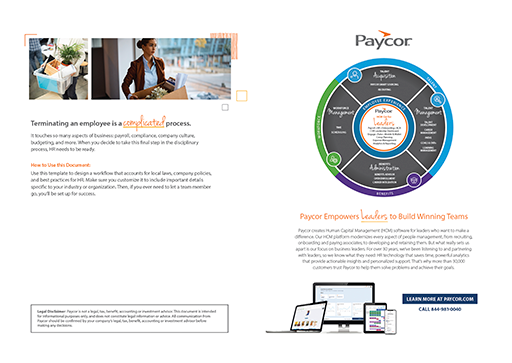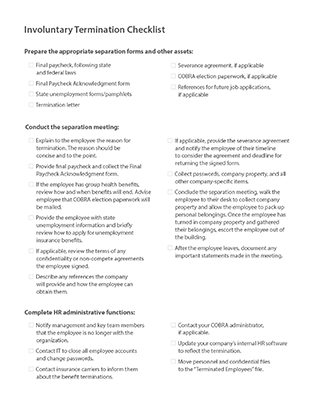Save Time Using Our Termination Checklist
Letting an employee go is never easy. When you have to part ways with someone, HR needs to handle it with professionalism and grace. By following a clear workflow, you’ll streamline the process even when emotions are running high. These procedures also help keep you compliant and avoid future legal issues. Customize Paycor’s downloadable checklist to make sure your team does everything by the book.
Deciding to Terminate an Employee
This is not a decision to make lightly. Before you terminate an employee, HR needs a clear, well-documented reason to let them go. Depending on your location, there might be some restrictions around the process.
Almost all U.S. states are at-will employment states, meaning the employer or employee can terminate their relationship at any time. However, many states have complex exceptions to that rule. In Connecticut, for example, employers cannot terminate an employee under an implied contract. Even if you live in an at-will state, make sure you document all the events leading up to termination. These records can protect you from compliance or legal issues.
In your records, reference your company policy and employee handbook in detail. Explain what rules the employee violated, and how. When an employee consistently breaks company policy, it’s probably grounds for termination – especially if they did so on purpose.
Even if they’re intentionally breaking rules, termination is rarely the first disciplinary step. It’s better for HR to take a progressive approach:
- Issue verbal and written warnings
- Implement a Performance Improvement Plan (PIP)
- Suspend the employee pending improvements or investigation
Throughout this process, HR should keep key stakeholders informed. Other company leaders will have valuable insight and support you and the employee throughout the disciplinary process. Make sure you connect with:
- The employee’s direct supervisor
- HR leaders familiar with company policies and relevant compliance issues
- Upper management (if relevant to the employee’s role)
- Your company’s legal team or contracted consultant
While getting input is important, termination isn’t always a consensus decision. Make sure your company policy outlines what to do in case leaders disagree.
The Costs of Termination
Terminating an employee is a lot more complicated than it sounds. This decision might have a long-lasting impact on your business, touching everything from company culture to your annual budget. Before you decide to part ways with a team member, it’s important to understand the costs:
- Administration: This includes the time and resources HR puts into the termination process. Your team will document the reasons for termination, conduct the exit interview, process final paychecks, talk to your insurance provider about discontinuing benefits, retrieve company property…the list goes on and on. Depending on the size of your company and the person’s role, these tasks can take up significant personnel hours.
- Recruiting and Onboarding Costs: Once an employee leaves, you’ll probably have to backfill their position. HR will create a job description, advertise for the opening, screen applications, conduct interviews, and coordinate with hiring managers to find the right fit. Hiring an entry-level employee typically costs about 20% of the person’s salary, and that percentage increases along with the role’s seniority (Zippia).
- Increased Insurance Premiums: Employers are responsible for paying FUTA and SUTA taxes, which are federal and state unemployment taxes. When an employee stops working with you for any reason – whether they quit, get fired, or get laid off – they can file for unemployment benefits. At that point, you’ll respond to the claim. You can validate it, agreeing that they qualify for benefits, or you can contest their claim. If an employee is fired for misconduct, they probably don’t qualify for unemployment benefits. Here’s how all this affects your company’s budget: approved unemployment claims can increase your SUTA tax rates. That could depend on several factors, like your location, company size, and involuntary turnover rates.
The exact cost of terminating an employee is different in every situation, but it’s always there. Sometimes it’s worth it. Either way, HR needs to approach this decision with care, compassion, and a clear procedure for what to do next.
The Process of Terminating an Employee
So you’ve carefully weighed the costs, connected with key stakeholders, and decided to terminate the employee’s contract. What should you do next? For HR leaders, your responsibilities fall into three main categories:
- Compliance: Ensure you’ve completed and filed all the necessary documentation in accordance with local and federal laws.
- Severance Meeting: This face-to-face termination meeting should be professional, compassionate, and clear.
- Post-Separation Administration: Once the employee leaves, the HR team will need to complete certain follow-up tasks to stay compliant and help the company move forward.
In the next sections, we’ll go over each of these categories in more detail.
Compliance
HR should collaborate with the legal team to stay compliant. Different laws apply to various states, industries, and companies of certain sizes. Even if you have a specific process for terminating employees, you’ll need to update it over time. Set a date each year to review your procedures and update them to comply with changing laws. You may be responsible for:
- Preparing a final paycheck according to state requirements
- Paying out PTO upon termination
- Announcing the termination to insurance companies and other benefits providers
- Writing a formal termination letter
- In some cases, negotiating and finalizing a severance agreement
- Sharing relevant information with a COBRA administrator
As you create a termination procedure, check with your legal team to see which of these steps are required. You may have to complete some of them – like writing a termination letter – before you meet with the employee.
Severance Meeting
In many cases, the employee will see this conversation coming. If they’re being fired because of poor performance or disciplinary issues, they’ll have plenty of warning. They might even see it as a relief. No one wants to work at a job that isn’t right for them.
A lot of people dread these conversations – even seasoned HR professionals. But they don’t have to be all bad. Here’s what NOT to do:
- Give them multiple inconsistent reasons for the termination
- Rush the meeting and skip over key details
- Vent your anger or take your feelings out on the employee
- Sugarcoat the situation
- Assign blame inaccurately or too harshly – including to yourself!
Instead, think of this meeting as an opportunity for growth. Sharing constructive feedback could help the person move forward with their career. The transition might be hard, but you can help them imagine getting through it successfully. Ideally, they’ll find a job that’s a better fit. During the meeting, make sure you share these key facts:
- The end date of their group health benefits
- Their COBRA rights
- Your state rules on unemploymentand how they can claim benefits
- Any references the company will provide
- The date by which you need them to return any paperwork, like a signed severance agreement
Once you give them the information they need, iron out these details together:
- Obtain any necessary passwords
- Coordinate the prompt return of company property
When the meeting ends, give them time to clear out their workstation and pick up any belongings. Then, respectfully escort them from the building. If the employee is belligerent, you might have a security guard or other team members see them out instead, to send the message that your severance meeting is over.
Post-Separation Administration
After an employee leaves your company, HR still has work to do. For example, you’ll probably need to:
- Inform management: Tell senior management and key team members what happened in the severance meeting.
- Announce their departure: Either HR or the person’s direct supervisor should make a company-wide announcement. Other employees should be informed that the person left the team. Don’t share any unnecessary information publicly.
- Coordinate with IT: Have the IT department delete any relevant accounts and change shared passwords.
- Update your HR Software: Update your payroll, benefits administration, talent management, and other relevant systems. Properly file all the former employee’s information, so you have it on hand if you need it again.
This list will be a little different for every company and every type of employee termination.
Get the Employee Termination Checklist
Every business needs a clear, thoughtful procedure for terminating employees. It’s essential to have these systems in place before you need them. If you’re just starting to design a termination process, Paycor’s checklist for terminating employees can help you get started.











